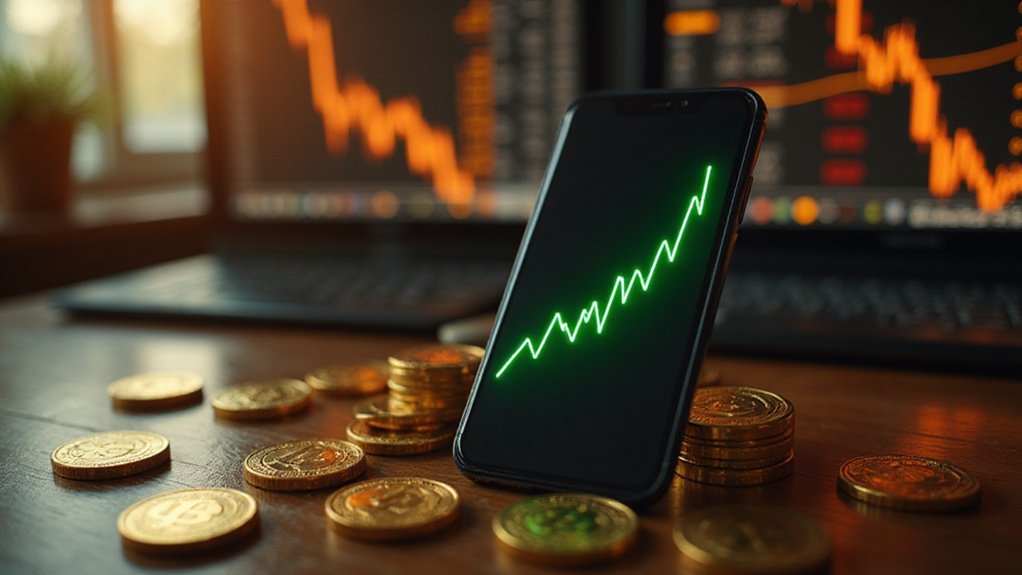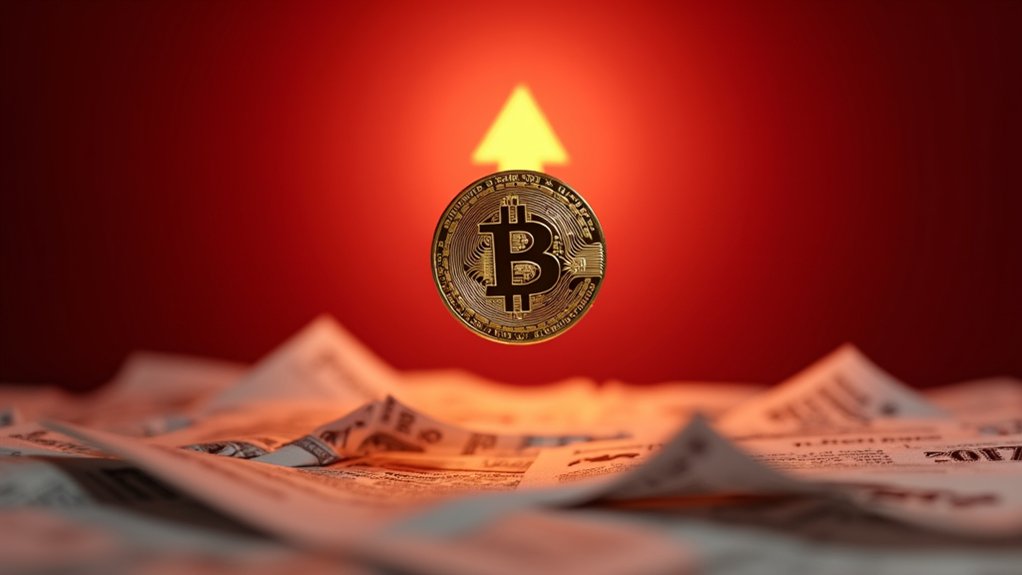USDC (USD Coin) represents a digital dollar that maintains a 1:1 peg with the U.S. dollar through full reserve backing—tokens are minted when users deposit actual dollars and burned upon redemption. Created by Circle and Coinbase, this stablecoin operates under U.S. regulatory oversight while facilitating 24/7 transactions and cross-border payments without traditional banking limitations. With over $26 trillion in transaction volume, USDC has become integral to DeFi protocols, offering stability amid crypto volatility while the deeper mechanics reveal sophisticated financial engineering.

The digital dollar has arrived, though perhaps not in the form central bankers originally envisioned. USD Coin (USDC), a fiat-backed stablecoin pegged 1:1 to the U.S. dollar, has emerged as one of the most significant iterations of digitized currency—ironically created not by government mandate but through private enterprise collaboration between Circle and Coinbase.
Unlike volatile cryptocurrencies that swing wildly on speculation and sentiment, USDC maintains its dollar parity through a straightforward yet elegant mechanism: every token in circulation corresponds to an actual U.S. dollar (or equivalent liquid asset) held in reserve. When users deposit dollars, new USDC tokens are minted; when they redeem, tokens are burned—a remarkably simple supply-and-demand ballet that maintains the essential 1:1 peg.
The reserve backing represents perhaps the most critical component distinguishing USDC from its more speculative crypto cousins.
Circle maintains 100% backing through liquid cash and cash-equivalent instruments, with regular independent audits providing transparency that would make traditional banks envious.
These attestations, published publicly, offer verification that the promised reserves actually exist—a novel concept in an industry often characterized by opacity.
USDC’s utility extends far beyond mere speculation.
The stablecoin functions as a stable store of value amid crypto market volatility while enabling 24/7 transactions that bypass traditional banking limitations.
Cross-border payments occur instantaneously at minimal cost, compared to the byzantine network of correspondent banks and settlement delays that plague conventional wire transfers. This efficiency has contributed to USDC achieving over $26T+ all-time volume across transactions, demonstrating massive scale adoption.
Decentralized finance applications have embraced USDC for lending, borrowing, and trading protocols requiring stable collateral.
The regulatory framework surrounding USDC provides additional legitimacy. Circle operates under U.S. regulatory oversight, implementing anti-money laundering (AML) and know-your-customer (KYC) policies that traditional financial institutions would recognize. This compliance structure facilitates integration with established financial systems while maintaining the technological advantages of blockchain networks. These measures help safeguard the financial system integrity by detecting and preventing the movement of illicit funds within USDC transactions. The company functions as a registered money service business under federal oversight, providing additional regulatory assurance to institutional users.
Operating across multiple blockchain networks, USDC has achieved broad compatibility and widespread adoption among exchanges, wallets, and payment processors. The result is a digital dollar that combines fiat stability with crypto efficiency—delivering the promised benefits of digital currency without requiring revolutionary monetary policy changes or central bank digital currency infrastructure.
Frequently Asked Questions
Can I Earn Interest by Holding USDC in My Wallet?
Yes, one can earn interest on USDC holdings through various wallet-based programs.
Coinbase Wallet offers 4.7% APY through its on-chain rewards program, while Trust Wallet provides competitive returns via its “Stablecoin Earn” feature.
These platforms allow users to maintain control over their assets while generating yield—a rather civilized arrangement for those seeking passive income without surrendering custody to traditional financial intermediaries or handling complex DeFi protocols.
What Happens to USDC if Circle Goes Bankrupt?
USDC reserves are legally segregated from Circle’s assets, theoretically protecting holders during bankruptcy proceedings.
The stablecoin’s reserves sit in dedicated accounts, shielded from Circle’s creditors through bankruptcy-remote structures.
However, this protection remains largely theoretical—no major stablecoin issuer has actually gone bankrupt, leaving holders in uncharted legal territory.
While S&P rates USDC’s stability as “strong,” the absence of precedent means redemption certainty depends on untested regulatory frameworks.
Is USDC Accepted on All Cryptocurrency Exchanges?
USDC enjoys widespread acceptance across major exchanges like Coinbase, Binance, and Kraken, though universal adoption remains elusive.
Regional regulatory constraints and licensing complications prevent some platforms from offering USDC trading or deposits.
Smaller, less-regulated exchanges may lack the infrastructure or compliance framework necessary for USDC integration.
While Circle’s regulatory adherence enhances institutional acceptance, jurisdictional restrictions still create notable gaps in global accessibility—a predictable outcome in crypto’s fragmented regulatory landscape.
How Long Does It Take to Redeem USDC for US Dollars?
USDC redemption typically requires up to two business days through authorized platforms like Circle or Coinbase, though processing times vary based on banking rails selected (ACH versus wire transfers) and institutional settlement procedures.
Users must complete KYC verification and transfer tokens to redemption platforms before initiating the process.
While some platforms offer expedited same-day settlement, external factors—including banking holidays and redemption volume—can introduce delays beyond standard timeframes.
What Are the Fees for Converting Between USDC and USD?
USDC-to-USD conversion fees vary dramatically across platforms, with Coinbase employing a tiered structure that exempts the first $40 million monthly before imposing escalating charges: 0.05% for $40-60 million, climbing to 0.30% beyond $500 million.
Smaller conversions often incur minimal fees, though spreads and market fluctuations can create subtle costs.
Exchange competition keeps retail rates competitive, while institutional volumes face increasingly punitive fee structures—apparently the price of moving serious money.









